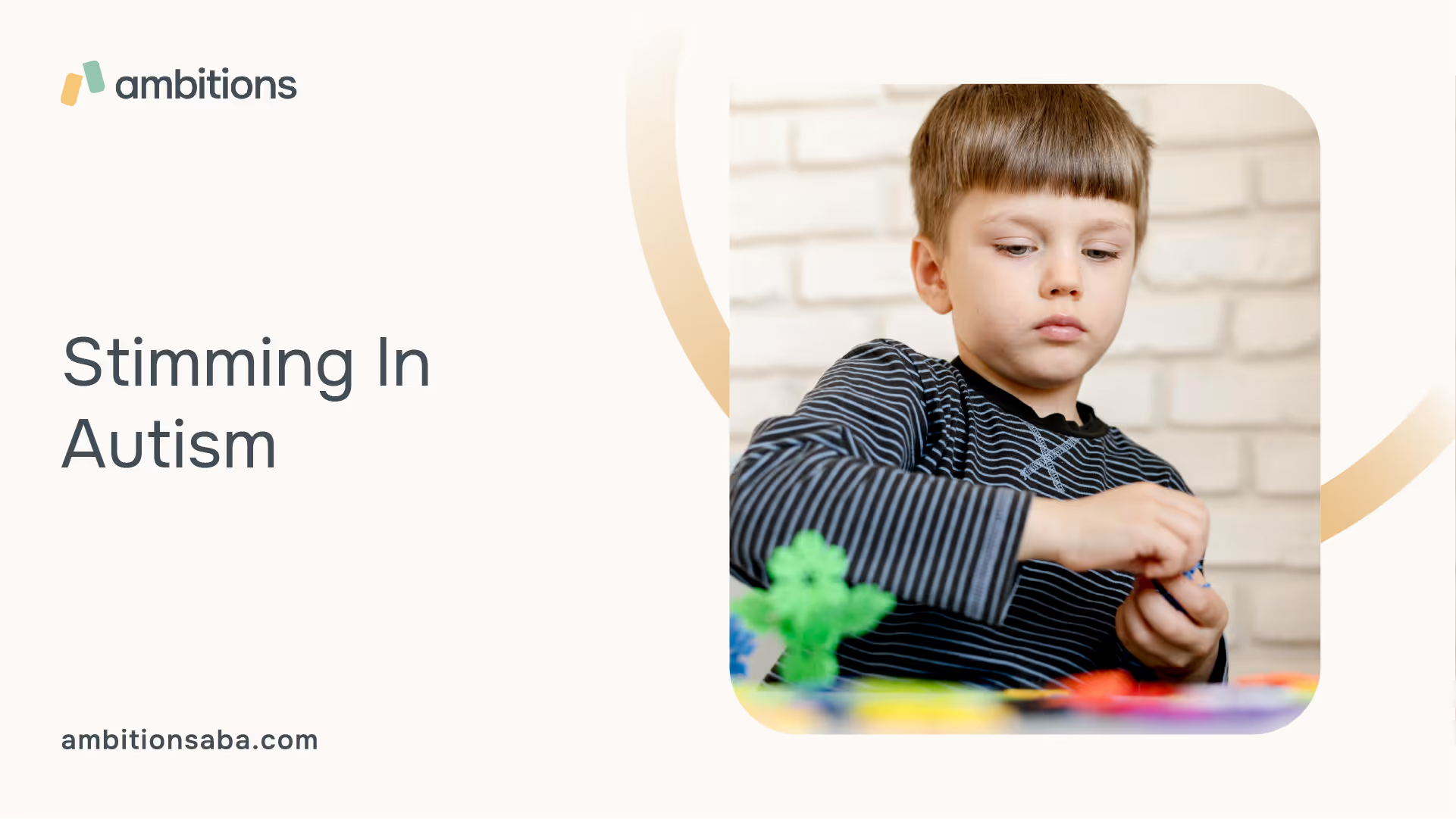Empowering Parents to Foster Communication Skills in Children with Autism
Stimming In Autism
For parents of children with autism, understanding stimming behavior is essential for providing support and creating a nurturing environment. This section will provide an overview of what stimming is and emphasize the importance of understanding stimming behavior in individuals with autism.

What is Stimming?
Stimming, short for self-stimulatory behavior, refers to a wide range of repetitive or self-stimulating behaviors commonly seen in individuals with autism. These behaviors can manifest in various forms, such as hand flapping, rocking back and forth, spinning, or vocalizations.
Stimming serves different purposes for individuals with autism, including self-regulation, sensory processing, and communication. It is important to note that stimming is a natural and inherent part of who they are, and it is not always a cause for concern or something that needs to be stopped. Instead, it should be understood and managed in a way that is beneficial to the individual.

The Importance of Understanding Stimming Behavior in Autism
Understanding stimming behavior in individuals with autism is crucial for several reasons. First and foremost, it helps parents and caregivers to recognize and interpret these behaviors accurately. By understanding the underlying reasons for stimming, parents can provide appropriate support and respond empathetically to their child's needs.
Furthermore, understanding stimming behavior can assist in creating an inclusive and accepting environment for individuals with autism. It helps reduce stigma and promotes a sense of understanding and acceptance among family members, peers, and the broader community.
By recognizing that stimming behavior is not just a random act but serves important functions for individuals with autism, parents can foster a positive and supportive environment. This includes providing opportunities for alternative outlets for stimming, promoting self-regulation skills, and seeking professional guidance when necessary.
Understanding stimming behavior in autism is an ongoing journey that requires patience, empathy, and education. By gaining insight into the purpose and significance of stimming, parents can better support their child's unique needs and foster a nurturing environment that celebrates their individuality.
Types of Stimming Behaviors
Stimming, short for self-stimulatory behavior, is a characteristic feature of autism spectrum disorder (ASD). It refers to repetitive and self-soothing behaviors that individuals with autism engage in. Stimming behaviors can vary widely among individuals and serve different functions. Here, we explore three common types of stimming behaviors: repetitive movements, sensory stimming, and self-stimulation.
Repetitive Movements
Repetitive movements are one of the most recognizable forms of stimming behavior in individuals with autism. These movements often involve repeating certain actions or gestures. Examples of repetitive movements may include:
- Hand flapping
- Rocking back and forth
- Finger flicking
- Body spinning
- Head banging
These repetitive movements can help individuals with autism regulate their sensory experiences, manage stress, and provide a sense of comfort. It's important to note that repetitive movements can vary in intensity and frequency among individuals.
Sensory Stimming
Sensory stimming involves seeking or avoiding specific sensory experiences. Individuals with autism may engage in sensory stimming to regulate their sensory processing or seek pleasurable sensations. Some examples of sensory stimming behaviors include:
- Tapping or rubbing objects for tactile stimulation
- Sniffing or smelling objects for olfactory stimulation
- Staring at or flicking lights for visual stimulation
- Making noise or listening to certain sounds for auditory stimulation
Sensory stimming allows individuals with autism to manage their sensory sensitivities and seek the sensory input they find soothing or stimulating. It helps them cope with overwhelming environments and find comfort in their surroundings.
Self-Stimulation
Self-stimulation, also known as self-stimulatory behavior or "stimming" for short, refers to repetitive actions that individuals with autism engage in solely for self-entertainment or self-soothing purposes. These behaviors are often repetitive, rhythmic, and may involve using objects or body parts. Some examples of self-stimulation include:
- Hand or finger tapping
- Finger or hand waving
- Body rocking
- Repeating words or phrases (echolalia)
- Spinning objects
Engaging in self-stimulation provides individuals with autism a way to regulate their emotions, reduce anxiety, and maintain focus. It serves as a self-regulatory mechanism to cope with their surroundings and promote a sense of calmness.
Understanding the different types of stimming behaviors can help parents and caregivers better support individuals with autism. By recognizing and respecting their stimming behaviors, creating a safe and supportive environment, and seeking professional guidance and support, we can foster a positive and inclusive space for individuals with autism to thrive.
Functions of Stimming Behavior
Stimming behavior in individuals with autism serves various functions and plays a significant role in their daily lives. Understanding these functions can help us better support and interact with individuals who engage in stimming behaviors. Here are three key functions of stimming behavior in autism:
Self-Regulation and Emotional Expression
Stimming behavior often serves as a means of self-regulation and emotional expression for individuals with autism. Engaging in repetitive movements or sensory stimming can help them manage their emotions, reduce anxiety, and cope with overwhelming sensory experiences. Stimming behaviors provide a way for individuals to regulate their internal state and find comfort in familiar repetitive actions.
For example, hand flapping or rocking back and forth may help an individual with autism relieve stress or express excitement. It is important to recognize that stimming behaviors are not necessarily negative or harmful; they can be a healthy and necessary coping mechanism for individuals with autism.
Sensory Processing and Sensory Seeking
Another function of stimming behavior in autism is related to sensory processing and seeking. Many individuals with autism experience differences in sensory processing, where they may be hypersensitive or hyposensitive to certain sensory stimuli. Stimming behaviors can serve as a way to modulate sensory input and seek the sensory experiences they crave.
For instance, hand flicking or finger wiggling may provide individuals with autism with the sensory input they need to feel grounded or focused. Exploring textures, bouncing, or spinning may offer a way to fulfill their sensory seeking needs and engage with the environment around them. Understanding the sensory aspects of stimming behavior can help create a more inclusive and accommodating environment for individuals with autism.
Communication and Social Interaction
Stimming behavior can also have communicative and social functions for individuals with autism. In some cases, stimming behaviors can convey specific messages or emotions. For example, flapping hands excitedly might indicate happiness or anticipation, while covering ears tightly may signal discomfort or sensory overload.
Additionally, stimming behaviors can influence social interactions by providing a sense of familiarity and comfort. Recognizing and respecting an individual's stimming behaviors can help create a safe and accepting environment, facilitating better communication and understanding.
By acknowledging the functions of stimming behavior in autism, we can embrace and support individuals with autism in their unique ways of self-expression, sensory regulation, and communication. It is important to remember that stimming behaviors are personal and can vary widely between individuals. Embracing these behaviors and providing appropriate support can contribute to a more inclusive and understanding society.
Recognizing Stimming Behavior
Recognizing stimming behavior is essential for understanding and supporting individuals with autism. Stimming, short for self-stimulatory behavior, refers to repetitive or stereotypical movements, sounds, or sensory activities that individuals with autism engage in. By recognizing these behaviors, we can gain insights into how individuals with autism express themselves and interact with their environment.
Common Stimming Behaviors in Autism
Stimming behaviors can vary widely among individuals with autism, but there are several common forms of stimming that are frequently observed. It's important to note that these behaviors can serve different purposes for different individuals, and not all individuals with autism engage in every type of stimming. Some common stimming behaviors include:
It's important to remember that stimming behaviors are not necessarily negative or harmful. They often serve as a way for individuals with autism to self-regulate, manage sensory input, and express their emotions. Understanding and respecting these behaviors can help create a more inclusive and supportive environment for individuals with autism.
Individual Differences and Personalized Stimming
While there are common stimming behaviors observed in autism, it's crucial to recognize that stimming is a highly individualized experience. Each person with autism may exhibit unique patterns of stimming that are specific to them. These personalized stimming behaviors can be influenced by various factors, such as sensory sensitivities, personal preferences, and environmental stimuli.
By recognizing and understanding the individual differences in stimming behavior, we can better appreciate the unique ways in which individuals with autism engage with their surroundings. It is important to avoid making assumptions or judgments about a person based on their stimming behaviors. Instead, it is crucial to focus on creating an accepting and inclusive environment that allows individuals with autism to express themselves comfortably.
Supporting Individuals with Stimming Behavior
When it comes to supporting individuals with stimming behavior, creating a safe and supportive environment is essential. Understanding and accepting stimming as a natural part of autism is crucial for providing the necessary support and accommodations. Here are some strategies to consider:
Creating a Safe and Supportive Environment
Creating a safe and supportive environment is key to helping individuals with stimming behavior feel comfortable and accepted. Here are some steps you can take:
- Educate yourself and others: Learn about stimming in autism and its importance for self-regulation and emotional expression. Share this knowledge with family members, teachers, and caregivers to promote understanding and acceptance.
- Foster a non-judgmental attitude: Avoid negative reactions or attempts to suppress stimming behavior. Instead, provide reassurance and understanding to ensure individuals feel safe and accepted.
- Establish consistent routines: Consistency and predictability can help reduce anxiety and provide a sense of security. Establishing daily routines and schedules can provide structure and stability for individuals with autism.
- Create sensory-friendly spaces: Some individuals with autism may be sensitive to certain sensory stimuli. Designating quiet spaces or providing sensory-friendly materials like weighted blankets or fidget toys can offer a calming environment.
Providing Alternative Stimming Outlets
While it's important to accept and accommodate stimming behavior, providing alternative outlets can help redirect or channel the stimming in a more socially acceptable way. Here are some strategies to consider:
- Offer sensory toys or tools: Providing a variety of sensory toys or tools, such as stress balls, textured objects, or chewable necklaces, can offer alternative sensory stimulation options.
- Encourage physical activity: Engaging in physical activities like yoga, dance, or sports can provide individuals with a sensory outlet and promote self-regulation.
- Implement visual supports: Visual schedules, social stories, or visual cues can help individuals understand and navigate their daily routines, reducing anxiety and promoting independence.
- Incorporate calming techniques: Teaching relaxation techniques, such as deep breathing exercises or mindfulness activities, can assist individuals in managing their emotions and finding calm.
Seeking Professional Guidance and Support
Seeking professional guidance and support is essential for understanding and supporting individuals with stimming behavior. Here are some avenues to explore:
- Consult with a healthcare professional: Reach out to healthcare professionals, such as pediatricians or psychologists, who specialize in autism to gain insights and guidance tailored to the individual's needs.
- Work with therapists: Occupational therapists or behavior analysts can provide strategies and interventions to address stimming behavior and help individuals develop coping mechanisms.
- Join support groups: Connecting with other parents, caregivers, or individuals with autism through support groups or online communities can provide valuable insights, advice, and emotional support.
Remember, supporting individuals with stimming behavior is a collaborative effort that involves understanding, acceptance, and patience. By creating a safe and supportive environment, providing alternative outlets, and seeking professional guidance, you can help individuals with autism thrive and embrace their unique selves.
FAQs
Is stimming only seen in autism?
No, stimming behaviors are not exclusive to autism. People with other developmental or neurological conditions may also engage in self-stimulatory behaviors.
Should stimming always be discouraged?
No, stimming should not always be discouraged. Stimming can provide a sense of comfort and control for people with autism, and is often a natural and necessary part of their daily routine. However, if stimming behaviors are harmful or disruptive, it may be helpful to explore alternative ways to manage these behaviors.
Can stimming change over time?
Yes, stimming behaviors can change over time. Some people with autism may develop new or different types of self-stimulatory behaviors as they grow and develop. It's important to continue to monitor these behaviors and adjust management strategies as needed.
Are there any benefits to stimming?
Yes, there can be benefits to stimming for people with autism. Stimming behaviors can provide a way to regulate sensory experiences, manage emotions and anxiety, and communicate with others. Additionally, some research suggests that engaging in self-stimulatory behaviors may help improve cognitive function and attention in people with autism.
Should parents/caregivers intervene when they see their child/students stimming?
It depends on the situation. If the child/student's stimming behavior is not causing harm or disruption, it may be best to allow them to continue engaging in these behaviors as needed. However, if the behavior is harmful or disruptive (e.g., biting themselves), it may be necessary to intervene and explore alternative ways for the child/student to manage their emotions or sensory experiences.
Summary
Stimming is a common behavior among people with autism, and while it can be disruptive or harmful in some cases, it is often a natural and important part of daily life. By understanding why stimming occurs and how it can be managed, we can help to support people with autism and provide them with the tools and resources they need to thrive.
Sources:
https://www.webmd.com/brain/autism/what-you-need-to-know-about-stimming-and-autism
https://www.healthline.com/health/autism/stimming
https://www.autism.org.uk/advice-and-guidance/topics/behaviour/stimming

